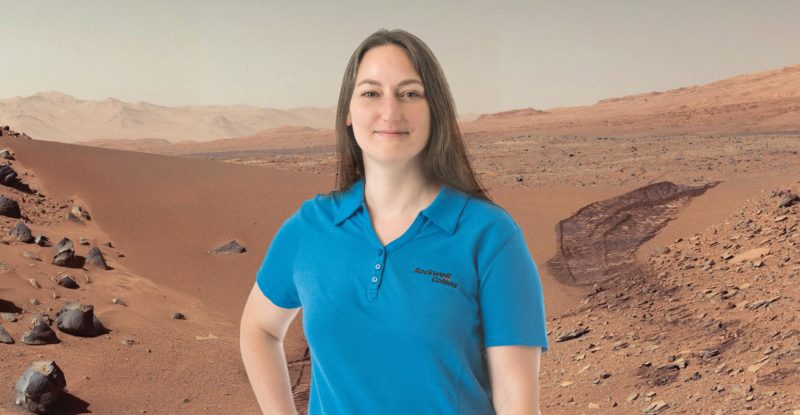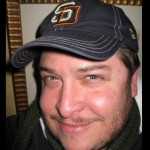Laura Smith-Velazquez is a human factors & systems engineer at Rockwell Collins’ Advanced Technology Center. She is also a pilot who has been working in the aviation and aerospace sector for close to fourteen years. And last year, Smith-Velazquez became one of 100 semi-finalists for the much-buzzed about Mars One mission – a one-way ticket to the red planet that is expected to launch in 2024.
RGN contributing editor Tomás Romero was fortunate enough to interview the very busy Smith-Velazquez recently about her extraordinary career path, the many strong, female role models in her life, her love of sci-fi, and how a potential one-way ticket to Mars could change everything.
Laura Smith-Velazquez grew up as one of six children in a large, extended Cherokee family in the small, Midwestern township of Dorr, Michigan. And though she knew from an early age that she was different from her classmates – who called her Pocahontas and couldn’t understand why her mother worked full-time and her father took care of the kids while studying to become an anthropologist – Smith-Velazquez says her strong sense of self was instilled from an early age by her fiercely matriarchal upbringing.
“Our family was quite a bit different culturally from those around us and I grew up rather poor,” says Smith-Velazquez. “[Cherokee] are matriarchal where the mother is the ‘head’ of the family and the men in our lives have a strong influence in sharing the responsibility of raising our children. [So] I have always had strong female role models.”
“When I was young we didn’t watch a lot of TV, but Nova and Star Trek were the few things we never missed as a family. This is probably the earliest influence I can remember.” Smith-Velazquez says she wasn’t really bothered by the dearth of strong female characters in Star Trek – which, Uhura aside, consisted mainly of comely alien love interests for Captain Kirk. That’s probably because what really captured her imagination as a young girl were science fiction novels.
“Anne McCaffrey is my favorite author and her novels are full of strong female characters that go out into space and conquer the galaxy, or at least the invading aliens,” jokes Smith-Velazquez.
She admits to being hugely influenced by the strong work ethic of her smart, hard-charging mother, who lived by the credo that “failure was just a part of learning and that it is how you stand back up, learn from it, and move on that creates success”. But two other women also had a profound impact on Smith-Velazquez’s decision to reach, quite literally, for the stars.
One of them was Mary Golda Ross, a pioneering Cherokee engineer who worked on the Apollo moon programs for Lockheed Martin and whose groundbreaking career path proved to Smith-Velazquez that Native-American women could do anything they set their minds to. And the other one was her grandmother, and namesake, Laura Smith.
“My Grandmother used to take me on walks in the woods [and] tell me stories about her life on the farm and her career at Steelcase where she built aircraft during the war. That was my first introduction to aviation,” remembers Smith-Velazquez. “This was together time for us and learning time for me. It’s how we passed on knowledge from generation to generation, experiencing together, learning from the world around us, and telling stories. [She] would tell me the Cherokee story about the Milky Way which inspired me to look up at the sky and [that] combined with the gorgeous, dark skies of the midwest … started my heart as an explorer. She taught me about the earth, about the sky, and all of the other directions for balance. We have seven directions that all represent aspects of balance and life. And even though, through the generations, she had lost the Cherokee words that I have [since] learned, the teaching was still there. Her love of the land, the sky, and all that is and will be.”
“This balance was not just about me though, but how I affected everything around me just by being, and the responsibilities we have for our actions and for each other, our brothers and sisters and even the trees [which] are called the ‘standing people’. We are a circle of life and in this circle together we must maintain balance together [and] this balance starts internally with self and family. You see, I didn’t grow up with the ‘girls do this’ and ‘boys do that’ culture. My parents never said: ‘You throw like a girl.’ We didn’t have these cultural stigmas because my parents refused them. I had examples every day of balance, strong women, and people who had confidence in me. We didn’t have much growing up, but we had that and it makes a world of difference in overcoming barriers.”
Which might explain why overcoming barriers comes so naturally to Smith-Velazquez. Channeling her love of the stars and sci-fi into her school work from an early age, Smith-Velazquez says she found her true calling pretty quickly.
“Most kids go through many stages, wanting to be many things when they grow up, but I have always wanted to be an astronaut,” she says. “Unfortunately there wasn’t much of a clear path to go to school to be an astronaut. So, I thought of getting into astrophysics, aerospace engineering, or becoming a pilot [and] I did get counseling to go into the military. Unfortunately, at the time women pilots were not allowed to fly combat so I decided against it. I was leaning towards being a pilot, then on the career bulletin board there was a postcard for Embry-Riddle Aeronautical University (ERAU). Everything was aviation and aerospace there and I didn’t apply to go to anywhere else. My parents were able to get me a plane ticket to Daytona Beach, FL for orientation and … I have wanted to dance the sky ever since.”
Supporting herself with a string of part-time jobs and student loans, Smith-Velazquez describes her time at ERAU – where she double majored in Aerospace Engineering and Aeronautical Science – as “awesome”. And she says that’s mostly because it was the first time in her life that she ever felt like she truly fit in with her peers. “Everyone [at ERAU] ate, breathed, and slept aviation/aerospace. We all shared the same love of science and flight no matter if you were business, computer science, becoming a pilot or computer scientist.”
And while Smith-Velazquez’s career as a commercial pilot never really took flight, a brief college internship in the Flight Safety Department at American Airlines proved to be rather fortuitous.
“During the internship I was introduced to Human Factors and ERAU had just started their Human Factors & System masters program. So I took my huge student loans and went back for more, and did both Human Factors engineering and Systems engineering concentrations, combining psychology with my love of aerospace.” The combination fit Smith-Velazquez like a glove and she was hired by Northrop Grumman while she was still working on her thesis. “I called my Mom from the parking lot after the interview … when I knew I’d finally made it … and she told me: ‘I know you will make it to Mars,'” remembers Smith-Velazquez. “This is one of my sweetest memories, because she died a year later.”
Currently working in Rockwell Collins’ Advanced Technology Center where she is designing a Sonic Boom Display for NASA Armstrong Flight Research Center to enable commercial supersonic transport while working on intelligent flight deck technology for NASA Langley Research Center and various other human autonomy teaming projects, Smith-Velazquez still finds time to give back.
A longtime member of such organizations as the American Indian Science and Engineering Society, Society of Women Engineers, and the Rosie Riveters non-profit which teaches girls to embrace STEM-related fields of study, Smith-Velazquez also teaches aerospace education for the Civil Air Patrol and helps Girl Scout troops across the county work towards their science and technology badges.
But despite the recent uptick of interest in STEM-related programs for girls, Smith-Velazquez says we still have a lot of work to do in this area as a society. “I think we have come a long way to encouraging and generally supporting women to enter STEM fields and get a STEM education, but that is where the improvements stop. We have not enabled women to stay in STEM fields.”
Look for more from Laura Smith-Velazquez – including the many difficult choices facing women in STEM-related fields, her personal experiences with gender bias in the workplace, and how sometimes reaching for your dreams can be the hardest choice of all – in part two of RGN’s Lean Into Aviation profile of the Mars One semi-finalist appearing next week.
Related Articles:










